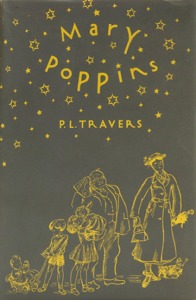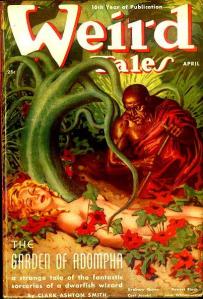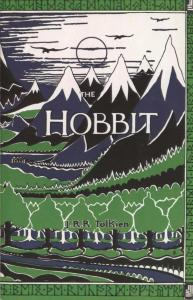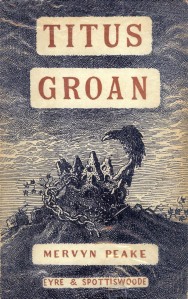The 30s and 40s were a crucial period for the fantasy genre. Not only did they see the publication of The Hobbit and the meeting of the Inklings group of fantasy writers, but also a rise in the number of pulp magazines publishing fantasy stories. While the genre had not yet become mainstream, the stories of these decades significantly contributed to its development and definition.
Below I’ve listed what I believe to be the 12 most significant fantasy works published between 1930 and the end of 1949, with their original covers where possible. Because some serialised stories didn’t appear in novel form till later decades, I’ve instead included the covers of magazine issues they featured in (if possible):
(To enlarge a cover simply click on it and the image gallery will open)
- Mary Poppins, P.L Travers, 1934
- Conan the Barbarian (Conan Chronicles), Robert E. Howard, 1932-1936
- Tales of Zothique, Clark Ashton Smith, 1932-1953
- Jirel of Joiry, C.L. Moore, 1934-1939
- The Virgin and the Swine (The Island of the Mighty), (Mabinogion Tetralogy), Evangeline Walton, 1936
- The Hobbit, or There and Back Again, J.R.R Tolkien, 1937
- The Sword in the Stone (The Once and Future King series), T.H. White, 1938
- The Enchanted Wood (The Faraway Tree series), Enid Blyton, 1939
- Fafhrd and the Gray Mouser Series, (Two Sought Adventure / Swords and Deviltry), Fritz Leiber, 1939-1988
- The Incomplete Enchanter (Enchanter Series / Harold Shea Stories) L. Sprague de Camp & Fletcher Pratt, 1941
- Titus Groan (Gormenghast series), Mervyn Peake, 1946
- The Well of the Unicorn, Fletcher Pratt (George U. Fletcher), 1948
The Inklings group met in Oxford in the 30s and 40s. Its members, which included C.S. Lewis and J.R.R Tolkien, not only wrote fantasy, but also some of the earliest scholarly writing on fantasy (e.g. Tolkien’s 1939 essay “On Fairy-Stories”) often pointing out that it could appeal to adults as well as children. While The Hobbit didn’t achieve the soaring levels of popularity The Lord of the Rings would later garner, it was none-the-less very popular after its publication in 1937, and set the stage for his later work.
This period was also important for comic fantasy and sword and sorcery / heroic fantasy. T. H. White’s The Once and Future King affectionately mocked elements of the King Arthur legend, and included anachronistic humour and social commentary. The magazine Unknown Worlds (founded in 1939) featured sword and sorcery tales with a comedic element, publishing the stories of writers like L. Sprague de Camp, Fletcher Pratt and Fritz Leiber.
Comics and superhero fiction also had their beginnings in this era, with Jerry Siegel and Joe Shuster’s Superman (1938) heralding the golden age of comic books from the 30s-50s. While these comics were not fantasy or novels, they had a significant influence on speculative fiction as a whole.
The end of this era was marked by the founding of The Magazine of Fantasy and Science Fiction (in 1949). Its prominent use of the word “fantasy” no doubt helped firmly establish the term for the genre (though it had been used earlier by other publishers, e.g. The Fantasy Press Publishing House founded in 1946).
A Few Interesting Facts
- A lot of 20s, 30s, 40s adult fantasy novels were ‘rediscovered’ and reprinted in the 70s (many by the Ballantine Adult Fantasy series) in response to the post-Lord-of-the-Rings rise of adult fantasy. As such, some works enjoyed their greatest popularity decades after original publication.
- Walton’s The Virgin and the Swine, the first of 4 volumes retelling the Welsh Mabinogion, sold poorly in the 30s, and none of the others were published at the time. It was rediscovered and reissued in 70s as The Island of the Mighty, followed by the 3 other books, forming what eventually became known as The Mabinogion Tetralogy.
- Fritz Leiber coined the term Sword and Sorcery to describe the kind of fantasy-adventure stories written by Robert E. Howard, in response to a letter from Michael Moorcock in the fanzine Amra.
- In addition to writing his own fantasy, L. Sprague de Camp continued Robert E. Howard’s Conan stories and also edited several anthologies, said to have sparked a renaissance of sword & sorcery in the late 60s.
- The Sword in the Stone was initially a stand-alone work, but was followed by shorter novels that were eventually compiled, revised and expanded on to create a tetralogy: The Once and Future King (published 1958).
- The Incomplete Enchanter is notable in that it bases its magic system on an intellectual system of symbolic logic.
- This is more an observation than a fact, but from looking at the above images, it would seem the scantily-clad-damsel cover trend has its roots in the magazine illustrations of this era!
Other 30s and 40s Works and Authors
There are some works that didn’t make it onto the list above that are none-the-less worth mentioning too:
- The short stories of H.P. Lovecraft (1890-1937)
- The short stories of Algernon Blackwood (1869–1951)
- Mistress of Mistresses by E.R. Eddison (1935) [Zimiamvian trilogy]
- The Circus of Dr. Lao by Charles G. Finney (1935)
- The Golden Key, or the Adventures of Buratino (1936) by Aleksey Nikolayevich Tolstoy
- The Little Grey Men: A Story for the Young in Heart by Denys Watkins-Pitchford (1942)
- Islandia by Austin Tappan Wright & Mark Saxton (1942)
- Darker Than You Think by Jack Williamson (1948)
- Silverlock by John Myers Myers (1949)
- Lost Horizon by James Hilton (1933) [an adventure novel with fantasy elements, and also a lost world novel. It was one of the early paperback “pocket books” and sold millions of copies, making it one of the most popular books of the 20th Century. It is the origin of the term ‘Shangri-La’]
- The Little Prince by Antoine de Saint-Exupéry (1943) [one of the best-selling books of all time. By some standards it’s fantasy, but it’s more often seen as an allegorical, magical realist work of literary fiction]
NOTE: I’m no longer mentioning science fiction works here unless they are particularly relevant to fantasy, because the two genres begin to diverge more obviously in this period, and with the proliferation of sci-fi in this era (the 30s and 40s are sometimes referred to as the golden age of science fiction) it would make my list too long!
___________________
Are any of these books a favourite? Or would you add another important novel to the list? Feel free to give it a mention in the comments.













Great post and very informative. I’ll have to check some of these books out 🙂
LikeLiked by 2 people
Thanks! I’ve been adding quite a few of these to my to-read list too. Many are books I’ve read a lot about but haven’t actually read – I plan to change that though 🙂
LikeLiked by 1 person
This was such a great idea!! I never realised that Titus Groan was published so far back!! I LOVE the Ghormenghast books!
LikeLiked by 4 people
I know the feeling, I’ve been surprised by the publication dates of quite a few books while putting these together! I suppose many just don’t reflect their age. I’ve never read Titus Groan but am very keen to!
LikeLiked by 3 people
You really should! The whole series is great!!
LikeLiked by 1 person
Yes do give the Gormenghast series a try if you can. You can’t compare the books to anything else, I found – they have the distinction of being quite unique.
LikeLiked by 1 person
It’s so cool to read about the golden age of fantasy and realise just how many of the books we now deem classics of the genre were written at this time. And it’s really interesting to read about the Inklings (I didn’t know that was the name for the group! So awesome!) It’s also good to know this is the point when sci fi and fantasy began to significantly diverge. Brilliant and educational post!
LikeLiked by 1 person
Yes I was impressed when I realised just how many important books were published in this period – it’s fun to see the genre really starting to take off and become a defined thing! And I love that they called themselves ‘Inklings’ too. Actually it sticks in my mind because when I did a post on fantasy awards a while back I was reading about the Mythopoeic Awards, and learned that they specifically award books that “best exemplify the spirit of the Inklings” and also give scholarships in “Inklings Studies” which I found really interesting, and which drew my attention to it. Anyway, I’m glad you liked the post!
LikeLike
It was T.H. White who got me reading fantasy as a freshman in high school, long, long ago. I bless his memory–and also nominate Mistress Masham’s Repose (1946), not as well known as the Sword in the Stone series, but just as good. White was a very learned man, arguably most at home with the 18th century, and Mistress Masham’s Repose is set on a Blenheim-like estate, where descendants of Lemuel Gulliver’s Lilliputians are still living on an disused island (the Repose) set in an ornamental lake. The plot is lively; Maria, the protagonist; is charming; and the style sparkles.
I’ve got three granddaughters who love this book as much as I do.
LikeLiked by 2 people
I’ve encountered many adaptations of and references to the Sword in the Stone but am ashamed to say I haven’t actually read any of White’s books – I really want to though, even more so now after reading your glowing opinion of him and his work! Mistress Masham’s Repose sounds really interesting. I had actually wondered if White was influenced by Gulliver’s Travels since it sounded like he might have a similar style to Jonathan Swift (with the humour and social commentary). I guess the Lilliputians make it very clear he was!
LikeLike
Really interesting post! Haven’t read many of them.
Was actually disappointed when I finally read Mary Poppins as it seemed so underwhelming compared with my favourite musical!
LikeLiked by 2 people
Thanks! With Mary Poppins I always think of the film (and the songs!), and I’ve actually never read the book. That’s a shame you found it disappointing, but I can see why – it’d be hard to beat the iconic songs, dances and performance of the musical version!
LikeLiked by 1 person
I’ve always loved the musical, right from when I was little. I find that reading a book before I see the film of it is fine, but doesn’t seem to work the other way round for me 🙂
LikeLiked by 1 person
Yes I feel the same – I always try to read books before seeing movie adaptations (if they’re books I’m interested in reading), because I know I’ll find it harder to read them after.
LikeLiked by 1 person
You have a really interesting point about the re-issues of the 1970s. I remember several of these, including the Pratt and Walton, and at the time thought they were contemporary authors. I had no idea they originally were published decades earlier.
LikeLiked by 2 people
That’s really interesting that you didn’t know at the time, but it makes sense since it looks like they presented them like new books. I also often didn’t realise about the original dates when looking them up, since they were usually shown with their 70s covers and mentioned in the context of other 70s books (and only occasionally with earlier dates, which confused me). Then when I learned about the re-issues it all finally made sense.
Btw I’m looking forward to getting to the 70s – so many important fantasy books from the 70s!
LikeLike
Pingback: The Genesis of Modern Fantasy? | W.L. Hawkin
As always, this series of posts makes me so excited!
I’m now reading (well, rereading) Enid Blyton’s “The Enchanted Wood.” I didn’t know I’d read it before and didn’t realize that it was the childhood book I’ve been searching for for years. I couldn’t remember the author or the title. I just knew I read the stories as a kid and there were illustrations and a garden and pixies and fairies. Been searching for this book for years and am SO glad I found it. It’s the book that got me hooked on fantasy. Now I’m trying to find the edition I read.
LikeLiked by 2 people
Oh I love that feeling when you find an old book you’ve been searching for for years!! So satisfying to have vague memories resolved in a re-read, and also to finally know the title. I don’t think I’ve read any Enid Blyton books (though who knows, maybe I also have and forgot 🙂 ) but I’m curious to, especially if they were what first got you hooked on fantasy.
Good luck finding the exact edition! If it’s any help, the Enid Blyton Society website has this page (that I got the cover image from) that lists all the editions and shows their covers. Might be useful!
LikeLiked by 1 person
Oh, it’s such a great feeling and the more I read the book, the more some of my early memories of it come back. It’s possible that you may have read. I think her books were pretty popular in the 1990s, or that may have been just among the kids in my class in Jamaica because I remember reading these books a lot like how kids consume Harry Potter books these days.
Thanks for the link! I’ve been checking that website to locate the right cover. 🙂
LikeLiked by 1 person
Pingback: What’s on Your Nightstand: October 2018 | Zezee with Books
A bit ashamed to say I’ve only read Tolkien and Blyton – must do better. Great post.
Lynn 😀
LikeLiked by 2 people
Yes I’ve also read very few of these – so have some serious reading to do!!
LikeLike
This is fantastic! The Hobbit is a favorite of mine. I may have to try to check out several of these when I get a chance. Thank you! I feel like I learned several new things about fantasy writing from these years.
LikeLiked by 1 person
Amazing post, Nicola! I have to say I’m not especially knowledgeable of the 30s/40s literature so this was incredibly helpful and educational 🙂 Sometimes I forget some of these books are actually that old! They feel so timeless and well-loved, as though they were released yesterday… It’s insane to think about how long it’s been!
I’ve also not read many of these, which is shameful but true xD I read The Little Prince recently and honestly did not love it. It was all right, but not as amazing and life-changing as I’d hoped it would be. I also read a few H.P. Lovecraft stories here and there but am not a huge fan. They’re perfect to read around Halloween time though!
LikeLiked by 2 people
Thanks Sophie! Yes many of them really don’t feel that old – crazy to think it’s been 80-90 years. But many do have that timeless quality, and I suppose as each new generation discovers them they feel new 🙂
Funnily enough I also wasn’t as blown away by The Little Prince as I’d hoped to be! I suppose I came to it with too many expectations (I also tried and failed to read it in the original French next to a translation, which only made it extra confusing and eventually I just read the translation!). I’ve only read one Lovecraft story and I don’t remember much about it – so I think I’ll have to read more to get a better sense of his work. Maybe next year at Halloween!
LikeLike
Yeah I just didn’t see what the big deal was… I mean, yes, it was super cute but it just didn’t touch me deep down or anything like that.
I’ll look forward to your Halloween reads then! 😀
LikeLiked by 1 person
Informative and creative post!
LikeLiked by 2 people
Fascinating! I never realized that how influential that time period was for fantasy! And I just realized that the Wizard of Oz experiences a rebirth during that time. Fascinating article! Very well done.
LikeLiked by 2 people
So glad you included Enid Blyton and Mary Poppins under fantasy books, I keep having this conversation with fellow book-friends and I never manage to explain myself very well at all. I think it’s something about how matter-of-fact the magic often is shown to be, there’s very little flashes and whiz-bangs, and I really enjoyed that about them when I was younger.
Also now I have fond memories of reading T.H. White’s Sword in the Stone over lunch in my school’s canteen and being so carried away by the story that I was constantly late for whatever class was straight after lunch…
LikeLiked by 1 person
True, they do have very matter-of-fact, understated magic, and in a real-world setting, which is really appealing. Too often I think they get overlooked as fantasy books because of that, and because they are children’s books too.
I was gifted a copy of The Sword in the Stone for Christmas so I’m looking forward to finally reading it! That’s a good sign it was so absorbing it made you late – I remember the same happening to me at school with other books. We actually had a scheduled 20min reading session every day, which was great, but the time was never enough and I often had to be told to put the book away, or was herded out of the room still reading it 🙂
LikeLiked by 1 person
Haha! Yes, many’s the time someone would have to shove me out of a room, still with my nose stuck into my book! My parents actually had to check up on my sister and I in the mornings before school to make sure that we hadn’t got distracted by a book and forgotten to get dressed!
Definitely approach The Sword in the Stone with caution, Merlin I remember as being extremely engaging and probably is the funniest version of him I’ve ever encountered. He’s got that ‘old man who’s too old to be bothered by much’ vibe, and I loved thinking about all the adventures he’s clearly had that lead up (or follow on from, in the case of Merlin’s life, I suppose…) to the story.
LikeLiked by 1 person
Haha that sounds very familiar – well, at least books are good things to be distracted by, so our parents and teachers can’t have been too annoyed 🙂
I’m looking forward to reading this version of Merlin, he sounds great!!
LikeLiked by 1 person
Pingback: Mythical, Mystical, Magical Reading Challenge 2021 (being edited) – Juulna’s 2021 Reading Challenges